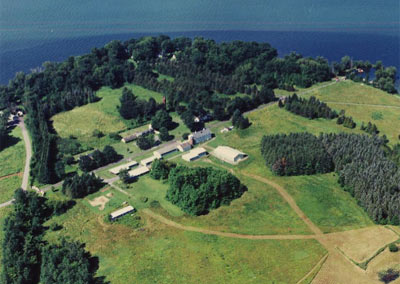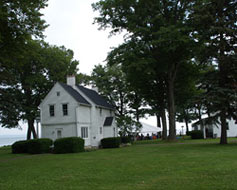Workshop on Oneida Lake focuses on trawl design
By Kara Lynn Dunn

One of Cornell's many outposts includes the Biological Field Station on Oneida Lake, a 439-acre property that serves as a unit of the Department of Natural Resources for research in fisheries and aquatic ecology in New York state.
For example, in November, the station hosted a three-day intensive trawling workshop that attracted 35 American and Canadian researchers and research vessel personnel representing all five Great Lakes. The workshop, sponsored by New York Sea Grant (NYSG), a cooperative program of the State University of New York, Cornell and the U.S. Geological Survey (USGS), brought in expertise on marine trawl design appropriate to central New York.

David B. MacNeill, a NYSG extension and fisheries specialist who co-organized the workshop, recently received a USGS Great Lakes Science Center Certificate of Appreciation for his efforts.
"This workshop was the best and most useful I have ever attended," said Brian Lantry, director of the USGS Lake Ontario Biological Station. "The numerous emails USGS has received attest to participants feeling the same. This type of work makes a realistic, practical contribution to science."
Collecting fish samples with large underwater nets (trawls) provides essential information for understanding food webs and managing fisheries resources.
Fishing gear and marine trawl evaluation experts from the Memorial University of Newfoundland's (MUN) Centre for Sustainable Aquatic Resources were on hand to offer their unique perspectives. MUN has the world's largest flume tank, which simulates real-world conditions. A week's worth of testing trawl models there can save months of work on the water with full-size nets.

"We were pleased to share what we know about fishing gear design and how to increase both trawl and fuel efficiencies, reduce ecological impacts and obtain the quality of data needed for fisheries science and development," said Paul Winger of MUN.
The workshop included numerous hands-on trawl exhibits and classroom time on design configurations, hydrodynamics, fish behavior impact on catch efficiency, environmental variability and new opportunities for evaluating trawl designs for use in the Great Lakes.
"Trawling is a very good tool for early detection of new invasive species," said workshop participant Gary Czypinski of U.S. Fish and Wildlife Service in Ashland, Wis. "I came hoping to gain an edge for catching Asian carp, which are very successful in evading a bottom trawl."
Spring-fall trawls have been cooperatively conducted by U.S. federal and state and Canadian provincial agencies on Lake Ontario since the 1970s.
"The mussels in Lake Ontario have forced us to change the gear we use. Understanding net performance and the latest technology for evaluating our gears will help us obtain the best data possible," said Mike Connerton, a New York State Department of Environmental Conservation research biologist stationed in Cape Vincent, N.Y.
New York Sea Grant Associate Director Kathy Bunting-Howarth commented, "This workshop is a fine example of what extension is all about -- transferring knowledge and empowering people to use science to its best result."
The workshop was funded by the Great Lakes Regional Research Network.
Kara Lynn Dunn is a freelance writer in Mannsville, N.Y.
Media Contact
Get Cornell news delivered right to your inbox.
Subscribe